
KOS Trip to Yorkshire & Lincolnshire. 15th to 17th June 2025
During the early days of the KOS, in the 1970s and 80s, a visit to Spurn Point was always included on our list of day trips. The journey took us along the north shore of the Humber, through Hull and on to Spurn. Year on year we could see the progress being made on the Humber bridge which was eventually opened in 1981, nine years after construction began in July 1972. On Sunday (15/6) we finally had the chance to drive over this elegant piece of British engineering en route to Far Ings nature reserve, the first of the four reserves we were to explore during our three day trip to Humberside.
Far Ings National Nature Reserve.
https://www.lincstrust.org.uk/get-involved/top-reserves/far-ings
The reserve is managed by the Lincolnshire Wildlife Trust and lies a short distance from the southern end of the Humber bridge. The picture at the top of this article was taken from just outside the visitor centre.
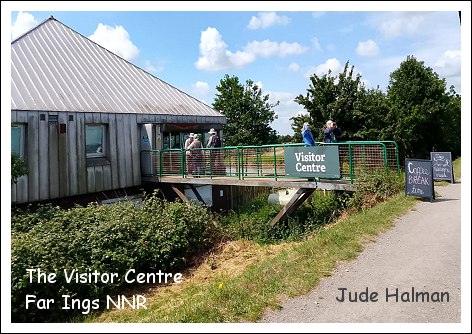 ........"Far Ings nature reserve is a diverse landscape made up of reedbeds, meadow and scrub, and both freshwater and saltwater environments. This varied habitat is rich in microscopic life and invertebrates, which in turn support fish such as perch and roach which provide a food source to a huge variety of birds including heron and kingfisher.
........"Far Ings nature reserve is a diverse landscape made up of reedbeds, meadow and scrub, and both freshwater and saltwater environments. This varied habitat is rich in microscopic life and invertebrates, which in turn support fish such as perch and roach which provide a food source to a huge variety of birds including heron and kingfisher.
Management work undertaken has improved the reedbed habitat and created more open feeding areas with the aim of attracting Bitterns back as a nesting species. After an absence of 21 years, Bitterns began breeding again in 2000"............
The visitor centre is an impressive two storey building with volunteers on duty to provide all the appropriate information required by first time visitors. They also have hot and cold drinks, ice creams and I even spotted some fresh home-made sausage rolls!
Overall trip leader Sheila Blamire also volunteered to lead this first part of the weekend, leading us initially along the wide, well-maintained path overlooking the river with extensive reedbeds in the foreground.
As usual I'd set a target for the trip - 80 this time and we were able to set the ball rolling from the visitor centre with Canada and Greylag Geese, Cormorant and Common Tern on the Pursuit Pit in front of the centre.
The river was a muddy brown colour, as a consequence of fine-grained sediment, primarily silt and clay, that is transported and deposited within the Humber Estuary. It didn't look very inviting and we saw no birds using it as we progressed. Reed Warblers and Reed Buntings sang from the reedbeds with Blackcaps in the pathside shrubbery; Swallows, Sand and House Martins overhead.
Leaving the main path we took a detour though the centre of the reedbed, picking up Cetti's Warbler and Water Rail for the list. There are extensive views of the reedbed from the double decker hide at Ness End farm and it wasn't long before we had good views of a Bittern in flight, as it trundled past before vanishing in the reeds.
It was a good day for Bitterns as we had two further views from a hide opposite the double decker, as well as a male Marsh Harrier, Red Kite, Great Crested Grebe and a very active Little Egret.
Returning along the coastal path we availed ourselves of the facilities before ending our visit to this splendid reserve with a short stroll around what's called the tadpole trail. It's not long, just a few hundred yards, but it produced Great Spotted Woodpecker, Greenfinch, Buzzard and Willow Warbler for the trip list. 52 species at far Ings, on day #1. A good start!
We stayed for two nights at the Goole Premier Inn. As we've come to expect, the rooms were spotless and everything worked! The food was fine and there were no complaints; I think we all appreciated the fact that the breakfasts were cooked to order and brought to the table. So much better than a buffet. As we enjoyed breakfast, I noticed one of the staff outside watering the hanging baskets - attention to detail and someone enjoying their job - nice to see!
I had been asked to lead day two (16/6) when we visited The RSPB's Blacktoft Sands and the Yorkshire Wildlife Trust's North Cave Wetlands.
Blacktoft Sands
This is a linear reserve standing on the banks of the river Ouse, just before its confluence with the river Trent to form the Humber. It has a central visitor centre and three hides on either side - so no chance of anyone getting lost!
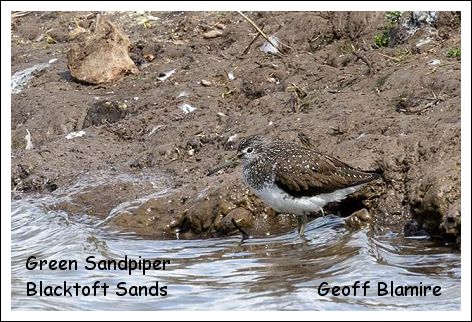 As we'd booked in advance we were met by volunteer Ian Richardson and Darren Johnson, the RSPB's Community Engagement Officer for Blacktoft Sands and Humber. As we'd booked in advance we were met by volunteer Ian Richardson and Darren Johnson, the RSPB's Community Engagement Officer for Blacktoft Sands and Humber.
With the aid of a large wall-mounted photograph Darren gave us a comprehensive presentation about Blacktoft and the rest of the area he covers before we set off.
New species for the trip came thick and fast with Skylark, Grey heron and Pochard available from the visitor centre plus Tree Sparrows in the undergrowth at the edge of the car park.
Leaving the visitor centre we turned to the right and headed down towards the Ousefleet hide via the two other hides en route. Blackcaps, Willow, Reed and Sedge warblers were all still in full song.
From the Ousefleet hide our first Avocet and a bonus bird - an early returning Green Sandpiper.
Next we walked past the visitor centre to the furthest hide, the Singleton. Most of the wildfowl were moving into their eclipse plumage, when their flight and tail feathers are shed simultaneously during their annual moult. We did though pick out many Mallard, Shoveler and Gadwall, as well as a drake Wigeon that hadn't moved north for the Summer.
The Townend Hide seemed to be a favourite with the local 'toggers (bird photographers) and their huge telephoto lenses. Our attention was drawn to a distant raptor attempting to chase down the local Sand Martins; it was unsuccessful and went on to quickly gain height before drifting away, becoming just a speck in the sky, even though binoculars. A Hobby our first and only sighting during the whole trip.
North Cave Wetlands
https://www.ywt.org.uk/nature-reserves/north-cave-wetlands-nature-reserve
Leaving Blacktoft Sands we drove back over the Ouse and up the M62 to the Yorkshire Wildlife Trust's North Cave Wetlands reserve. A journey of 40 minutes but well worth the effort, it's a cracking place!
.........." The original 40 hectare site was acquired by Yorkshire Wildlife Trust in 2001. In the following three years 250,000 tonnes of material was moved in, out or around the site to create a suitable open wetland habitat, with established trees confined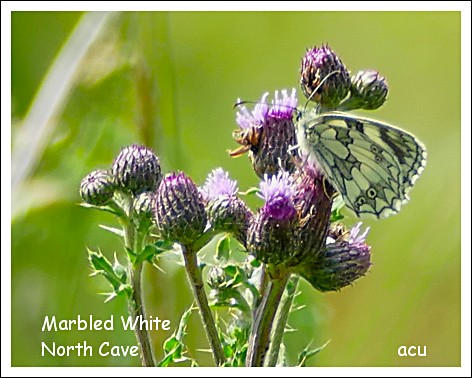 to the boundaries and to the western end. Six large lakes provide both deep and shallow water with wide margins and islands, connected underground to give control over winter and summer water levels. to the boundaries and to the western end. Six large lakes provide both deep and shallow water with wide margins and islands, connected underground to give control over winter and summer water levels.
Starting in 2008 and finishing 12 to 15 years thereafter an additional 100ha of land to the immediate south and west is being quarried. This will be progressively restored with wildlife in mind before being gifted to Yorkshire Wildlife Trust.
Walking at North Cave Wetlands
A circular footpath runs around the perimeter of the reserve which take one to two hours to complete. Footpaths are mainly grass and stone surface - all on a flat level for very easy walking, wheelchairs and pushchairs. The stone paths are accessible all year round but grass paths can get very muddy in winter.
Five hides on site East, South, North, Turret and Crosslands. All hides except Turret are fully accessible with wheelchair viewing space. All hides have benches."............
The only disappointment was that the "Little Butty Bus" wasn't in situ. The owners were taking their annual holiday!
The large car park is adjacent to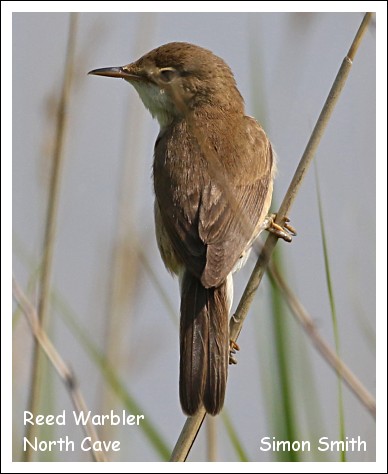 the first viewing point - a substantial structure with tables, benches and open sides, giving great views over the reserve. It gave a welcome respite from the sun, the temperature was already up to
23⁰C
and anyone who didn't fancy walking all the way around the reserve could spend their time there. the first viewing point - a substantial structure with tables, benches and open sides, giving great views over the reserve. It gave a welcome respite from the sun, the temperature was already up to
23⁰C
and anyone who didn't fancy walking all the way around the reserve could spend their time there.
In front of us, on the Village Lake, Common Terns, Lapwing, Shelduck, Reed Warbler and "new" ones in the form of Oystercatcher and Little Grebe. Along the way over to the Turret Hide that we could see in the distance - Willow Warbler, Blackcap, Chiffchaff and Goldfinches all in song. A black and white butterfly in front of the hide initially caused some confusion until it landed on a thistle head and we were able to identify it as a Marbled White. A handsome little creature that I've never seen before.
A couple we met in the Turret Hide told us they been watching an Otter on the Main Lake, we'd be visiting it later.
Moving on along the stony path past the Island Lake and Reedbed Lake we had Red Kite, Whitethroat, Cetti's Warbler, Linnets and a distant Cuckoo calling - they'll be on their way back to Africa soon, as we approach the longest day. Then it's downhill all the way to Christmas!!
The Crosslands hide, standing at the top of Dryham Lane, is another substantial affair, it has a timber frame with straw bale infill and overlooks the new meadowland to the east. In a pool close by, a Green Sandpiper was our second of the day. Some of the party decided to continue down the lane to catch up with a family of Little Owls that have nested down there but they came back disappointed - you just can't get the staff nowadays.
I walked back to the car park via the Main Lake where the otters had been seen earlier but also drew a blank.
This is an excellent reserve and well worth a visit at any time of the year. It promises to be even better in the future as sand and gravel extraction cease and even more of the area can be managed for nature.
61 species today, of those 19 were new bringing the running total to 71. Only 9 to go to reach the target of 80 for the trip!
Day #3 Fairburn Ings
https://www.rspb.org.uk/days-out/reserves/fairburn-ings
Day#3 and reserve number four found us at Fairburn Ings, just off the M62 and a convenient stopping off point on the road back to Cheshire. Simon and Lyn recorded a new species for our trip list as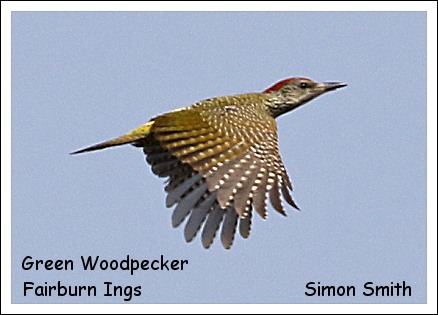 they drove away from the Premier Inn at Goole. A flock of Rooks were scavenging in the waste bins outside the nearby McDonald's - species #72, followed by a jay from the Fairburn car park #73! Sheila again took us under her wing and, after a consultation with the very helpful reserve warden, decided that we'd follow the Roy Taylor trail in the morning and then, in the afternoon, it would be the Riverbank trail. they drove away from the Premier Inn at Goole. A flock of Rooks were scavenging in the waste bins outside the nearby McDonald's - species #72, followed by a jay from the Fairburn car park #73! Sheila again took us under her wing and, after a consultation with the very helpful reserve warden, decided that we'd follow the Roy Taylor trail in the morning and then, in the afternoon, it would be the Riverbank trail.
The reserve map from the RSPB's website tells us that the Roy Taylor trail is 2.4Km long and should be completed in 45 minutes. It took us 2 hours at our usual birdwatchers pace!
A Reed Warbler was singing from a small reedbed as we walked away from the visitor centre and the advance party had a Kingfisher at the appropriately named Kingfisher screen #74. Just beyond the screen a singing Goldcrest took our tally to #75.
The trails at Fairburn are wide and, being made of crushed stone, easy to walk on but there are some steep bits and was glad to rest for a few seconds as we watched a Green Woodpecker #76 powering over. Simon did well to get on to it and his picture reveals it was a juvenile bird.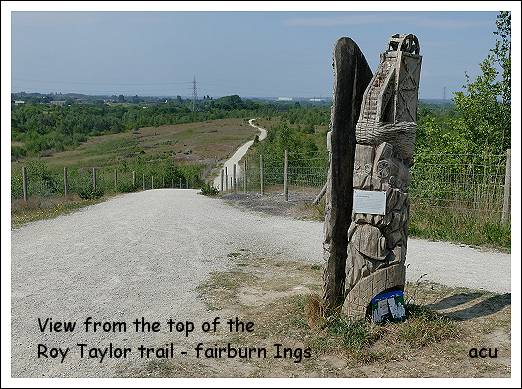
Reaching the top of the trail we enjoyed spectacular views over the surrounding area before turning left to follow the trail past the heronry. On the way another butterfly puzzle, this time the consensus was that we were watching a Clouded Yellow, unfortunately no one managed a snap.
Two flashes appeared below us as we progressed and the ever alert Pat Sponder identified both Spoonbill and Cattle Egret - species 77 and 78. #79 came in form of a Mediterranean Gull spotted by Sheila with our target being reached as we clocked a Great White Egret flying over the flash below.
Lunch was taken in the visitor centre (a selection of filled rolls, ice creams and hot and cold drinks are available) before we headed out again, up the hill to the start of the Riverbank trail. It was pleasant walking along the tree-lined track down to the Bob Dickens Hide, overlooking the Main Bay, accompanied by the songs of Chiffchaffs, Blackcaps and Willow Warblers. I've not heard so many of the latter for a long time.
In front of us on the flash - Cormorant, an incubating Great Crested Grebe, a large family party of Shelducks, Canada and very vociferous Greylag Geese. Some of the party carried on down the trail to Charlie's Hide, right at the far end, hoping for the Willow Tits. They didn't find any but had good views of a Kingfisher.
This brought to an end our three days in Yorkshire and Lincolnshire; four reserves, two of which were new to us, and exactly 80 different species. Geoff tells me that we walked 22.4Km (Far Ings - 5.41km: Blacktoft Sands - 3.35Km : North Cave - 4.88Km : Fairburn Ings - 9.80Km.
Our thanks go to Sheila for planning the trip and acting as leader for two days and, of course, all the team who came along - we must do it again sometime!
Species recorded during the three day field trip to Yorkshire and Lincolnshire. 22nd to 24th June 2025.
Day #1 - Far Ings. Great Crested Grebe, Cormorant, Bittern, Little Egret,Mute Swan, Greylag Goose, Canada Goose, Mallard, Tufted Duck, Red Kite, Marsh Harrier, Buzzard, Kestrel, Water Rail, Moorhen, Coot, Lapwing, Black-headed Gull, Lesser Black-backed Gull, Common Tern, Stock Dove, Woodpigeon, Collared Dove, Swift, Great Spotted Woodpecker, Sand Martin, House Martin, Swallow,Pied Wagtail, Wren, Dunnock, Robin,Blackbird, Song Thrush, Mistle Thrush, Cetti's Warbler, Sedge Warbler, Reed Warbler, Blackcap, Chiffchaff, Willow Warbler, Long-tailed Tit, Blue Tit, Great Tit, Magpie, Jackdaw, Carrion Crow, House Sparrow, Chaffinch, Greenfinch, Goldfinch, Reed Bunting.
Day #2 additional species Blacktoft Sands and North Cave. Little Grebe, Grey Heron, Shelduck, Wigeon, Gadwall, Shoveler, Pochard, Sparrowhawk, Hobby, Pheasant, Oystercatcher, Avocet, Green Sandpiper, Cuckoo, Skylark, Whitethroat, Raven, Tree Sparrow, Linnet,
Day #3 additional species Fairburn Ings Spoonbill, Mediterranean Gull, Kingfisher, Green Woodpecker, Goldcrest, Jay, Rook, Cattle Egret, Great White Egret.
[ ✓ 80]
|
|
|